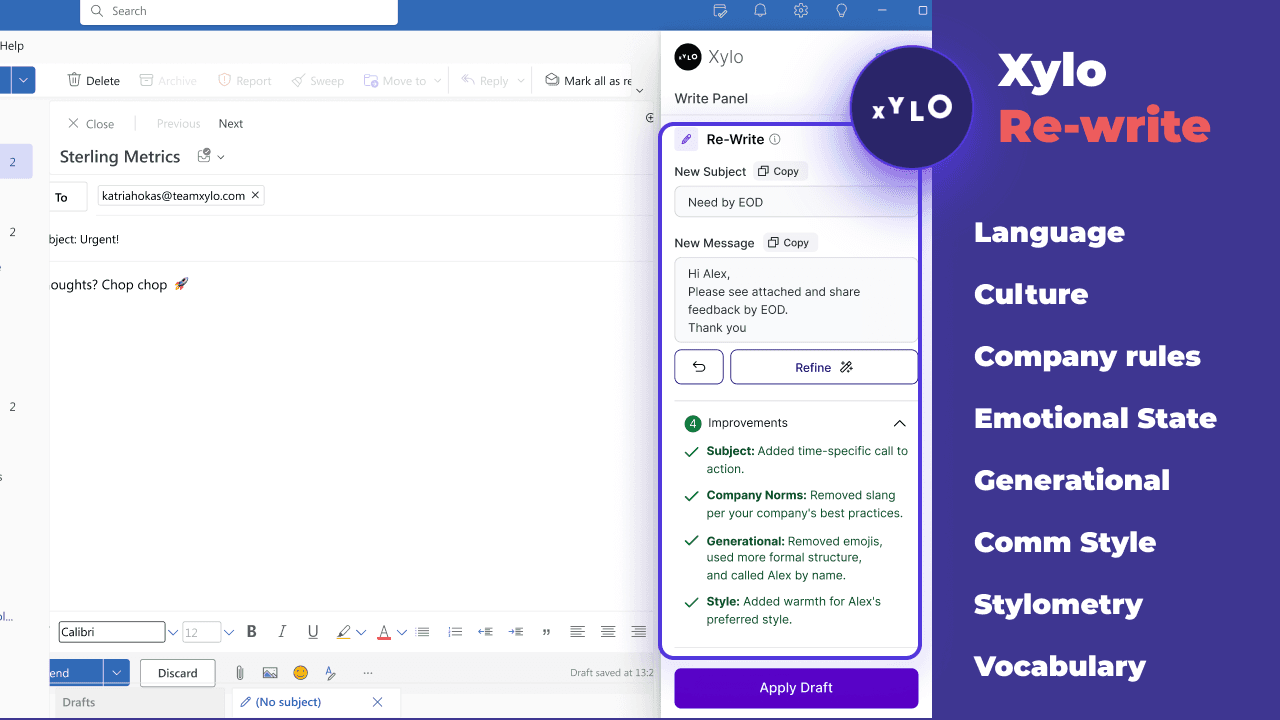How to Cautiously Use AI for Work: A Comprehensive Guide for Today’s Workplace
November 13, 2024
How to Cautiously Use AI for Work: A Comprehensive Guide for Today’s Workplace
Xylo for Business
How to Cautiously Use AI for Work: A Comprehensive Guide for Today’s Workplace
Artificial intelligence (AI) has evolved from a mere technological buzzword to a disruptive force that has revolutionized the way businesses operate and the way work is completed in recent years. While AI holds tremendous potential to enhance productivity, streamline operations, and unlock new insights, it also comes with challenges and ethical considerations that companies and individuals must navigate carefully.
For anyone looking to use AI responsibly and effectively in the workplace, this guide offers a comprehensive overview of the considerations, best practices, and potential pitfalls. Let’s dive into how to cautiously use AI for work and ensure it’s a tool for positive impact rather than unintended consequences.
In this article:
Benefits and Risks of Using AI at Work
Practical Steps to Using AI Cautiously in the Workplace
Examples of AI in the Workplace: Use Cases and Best Practices
How to Ensure Ethical AI Use in the Workplace
The Future of AI in the Workplace: Balancing Innovation with Responsibility
Navigating the Path Forward: Embracing AI Responsibly
The Rise of AI in the Workplace: A Game-Changer with Cautionary Tales
Artificial intelligence is being adopted across various industries at an unprecedented rate. From automating mundane tasks to helping in decision-making processes, AI's applications in the workplace have proven beneficial for many organizations. For example, tools like Xylo AI’s email writer can enhance communication efficiency, while predictive analytics can help marketing and sales teams anticipate customer needs.
However, it’s essential to recognize that AI isn’t a magic solution. Blindly implementing AI in the workplace can lead to bias, loss of control, security vulnerabilities, and potential impacts on employee morale. As such, adopting a cautious and strategic approach is essential.
Benefits and Risks of Using AI at Work
Benefits of AI in the Workplace
Enhanced Productivity: AI can perform repetitive tasks faster than humans, freeing employees to focus on high-value activities. For example, AI can help customer service teams with automated responses to common inquiries, enabling quicker service.
Data-Driven Decisions: AI can analyze vast amounts of data to uncover trends and insights that may be difficult to spot manually. This is particularly useful in fields like marketing, finance, and healthcare.
Improved Accuracy: AI-driven tools often have high levels of precision, which can help reduce errors in tasks such as financial calculations or document proofreading.
Personalized Communication: Tools like Xylo AI’s email writer can create customized responses, which helps to improve engagement while reducing the workload for employees who manage communication.
Risks of AI in the Workplace
Bias and Fairness Issues: AI models trained on biased data can perpetuate those biases. In hiring, for example, if an AI model is trained on historical data that reflects past discrimination, it could replicate that bias in its recommendations.
Job Displacement Concerns: AI automation has sparked concerns about job security for certain roles. While AI can enhance productivity, it may also replace specific tasks, leading to job restructuring or elimination.
Data Privacy and Security Risks: Implementing AI often requires access to sensitive data, which can create potential security vulnerabilities if not managed properly.
Over-reliance on AI: Relying too heavily on AI can lead to reduced human judgment, potentially resulting in poor decisions if the AI model misinterprets data.
Practical Steps to Using AI Cautiously in the Workplace
1. Understand Your AI Tools and Their Limitations
Before implementing any AI tools, make sure you understand their capabilities and limitations. AI can handle specific, repetitive tasks but often lacks the nuance needed for complex decision-making. Analyzing a tool's use cases and boundaries will help you avoid situations where AI could make mistakes or miss important context.
Example: In communication tasks, Xylo AI’s email writer can draft personalized messages efficiently. However, final editing may still be necessary to ensure the tone and content align with company values.
2. Conduct Risk Assessments and Bias Audits
Regularly assess your AI tools to identify potential risks, including bias and discrimination. This is especially critical if you’re using AI in sensitive areas like hiring, customer profiling, or performance evaluation.
Bias audits, where data and algorithms are tested for discriminatory patterns, can reveal areas that need adjustment, allowing you to minimize risks before they impact operations.
3. Start with Pilot Programs and Scale Gradually
Avoid deploying AI tools across the organization all at once. Instead, begin with pilot programs that allow you to evaluate AI's performance and impact on a small scale. Pilot testing can also reveal how well employees adapt to the technology and identify areas for improvement.
Example: Implement AI-driven task management tools in specific departments before expanding organization-wide. This helps avoid large-scale disruptions if adjustments are needed.
4. Prioritize Data Security and Privacy
AI relies heavily on data, which makes it essential to have strong data governance and security practices in place. Establish clear policies on data usage, access controls, and encryption to safeguard sensitive information.
Example: When using AI to analyze customer data, anonymize personal identifiers whenever possible to minimize privacy risks.
5. Empower Employees Through AI Training and Upskilling
A significant part of using AI cautiously involves ensuring employees understand how to interact with AI tools. Upskilling programs can help employees learn how to maximize AI's potential while recognizing areas where human intervention is necessary.
Example: Train customer service teams on when to use AI chatbots versus when to escalate inquiries to a human representative for a more personalized touch.
Examples of AI in the Workplace: Use Cases and Best Practices
1. AI for Email Management and Communication

Best Practice: Tools like Xylo AI’s email writer can help streamline and personalize email communication, especially for employees who handle high volumes of messages daily. However, ensuring employees review AI-generated emails can maintain a human touch.
2. AI for Recruitment and Hiring
Best Practice: AI can streamline the recruitment process by scanning resumes and recommending candidates. To avoid biases, use diverse data sets and conduct regular audits on the algorithm’s selections.
3. AI for Marketing and Customer Insights
Best Practice: AI-powered analytics can help marketing teams predict customer behavior and personalize campaigns. However, balance AI insights with human intuition to avoid overly rigid customer segmentation.
4. AI for Task Automation in HR
Best Practice: HR departments can use AI to manage routine tasks like payroll and scheduling. However, keep human oversight to ensure that any unique employee situations are handled appropriately.
How to Ensure Ethical AI Use in the Workplace
Using AI cautiously also means considering the ethical implications of its use. Here are some steps to ensure AI remains a positive force in your organization:
1. Adopt Transparent AI Policies
Transparency is essential to building trust. Make sure your employees know how AI is used within the company, the data it relies on, and how it influences decision-making.
2. Establish Clear Accountability
For every AI tool in use, designate accountability to ensure there’s always someone responsible for its performance, maintenance, and ethical use. This helps avoid situations where AI errors go unaddressed.
3. Commit to Continuous Monitoring and Improvement
The AI landscape is constantly evolving. Regularly revisit your AI tools to assess whether they continue to meet your company’s ethical and operational standards. Update or retrain models as necessary to adapt to changing needs or new data.
4. Encourage Employee Feedback
Employees often interact directly with AI tools, so their feedback is valuable for identifying potential issues or areas for improvement. Make it easy for employees to voice concerns or suggest enhancements.
The Future of AI in the Workplace: Balancing Innovation with Responsibility
The future of AI in the workplace is promising, with advancements expected in personalization, predictive analytics, and automation. However, as AI capabilities grow, so does the need for caution. Responsible AI use means balancing innovation with ethical considerations, ensuring AI serves as an enhancement rather than a replacement for human judgment.
With companies like Xylo AI leading the charge in communication enhancement, there’s enormous potential for AI to improve efficiency and productivity. But by following best practices, conducting thorough assessments, and prioritizing ethical considerations, organizations can harness AI’s power responsibly and effectively.
Navigating the Path Forward: Embracing AI Responsibly
AI holds transformative potential for the workplace, from improving productivity to driving data-driven insights. However, using AI cautiously is essential to avoid pitfalls such as bias, over-reliance, and data privacy risks. By understanding the limitations of AI, conducting thorough assessments, and training employees, companies can implement AI in a way that supports their goals without compromising values or employee well-being.
Remember, successful AI adoption isn’t just about technology—it’s about thoughtful integration that respects the people it serves. For companies looking to embrace AI in the workplace, cautious implementation, clear policies, and a commitment to continuous improvement will be key to unlocking its full potential.
👉 Take the first step towards responsible AI adoption — Schedule a call with Xylo AI experts and empower your team today!
Related articles



